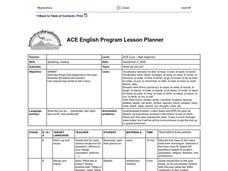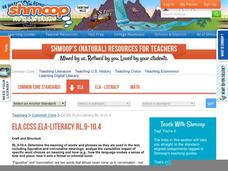ESL Kid Stuff
Places in My Town
Introduce language learners to the present continuous tense with a series of activities that ask them to answer the question, "Where are you going?"
Novelinks
Wildwood Dancing: Questions using Bloom’s Taxonomy of Thinking Process
Readers respond to a series of questions focused onJuliet Marillier's young adult novel Wildwood Dancing, and crafted to reflect the levels in Bloom's Taxonomy.
TLS Books
Dictionary Skills Review
Why do we use a dictionary? Your scholars will tell you why while demonstrating their dictionary skills. In addition to stating the purpose of using dictionaries, they will also show what they know about guide words, alphabetizing,...
K12 Reader
Adverbs of Frequency II
Describe your daily activities with adverbs of frequency. Kids recall which things they seldom do, they rarely do, they frequently do, and the things that they never do.
K12 Reader
Working with Adverbs
Encourage critical thinking with a grammar exercise that focuses on adverbs and adverbial phrases. Kids read the first parts of 16 sentences, then decide which question to answer (how, how much, where, or when) based on the context, and...
One Pot Learning
Reading Comprehension Worksheet
Three annotated passages from Ralph Waldo Emerson's essay on "Nature" provide young philosophers a chance to improve their reading comprehension skills as they gain insight into Emerson's ideas.
Curated OER
ESL: Non-Progressive Verbs
In this ESL non-progressive verbs worksheet, students read examples, then complete multiple choice questions, selecting correct sentences and determining correct simple and present progressive tense activities.
Curated OER
English Exercises: Present Simple Tenses
In this online interactive English learning exercise, students respond to 29 fill in the blank questions that require them to use forms of "to be" appropriately. Students may submit their answers to be scored.
Internet Archive
Introduction to Latin Language
Begin teaching your learners—and yourself—some basics about the Latin language with the inquiries available in this resource. Although the questions are linked to a textbook of unknown origin, they offer a good beginning on where to...
LearnEnglishFeelGood.com
Gerund or Infinitive?
Decide which form of the verb to use in ten sentences. Young grammarians watch for context clues when determining if they should use gerunds or infinitives in the blank spaces of each sentence.
Curated OER
Spanish Video Project - Me Gusta…
Find out what your Spanish pupils like and dislike with an oral presentation in the form of a video, poster, or PowerPoint. The assignment page provides requirements for the project in paragraph and checklist format. Pairs can use the...
Curated OER
Verbs 1
In this ESL verbs vocabulary worksheet, learners analyze 7 pictures that depict people doing different activities. Students match these pictures to the verbs that describe them.
Curated OER
ESL Vocabulary: Confusing Verbs
In this ESL "confusing" verbs learning exercise, middle schoolers use a drop down list to select the verb that correctly fills in a blank in a sentence, 7 sentences total.
Curated OER
The Passive Voice Exercise
A clear example of a sentence in both active and passive voice is shown at the top of this resource and gives writers a clear example to follow. For the next 12 sentences, they change the voice from active to passive.
Curated OER
What Did You Do?
English learners practice using the past tense by participating in a time description activity. They identify the differences between verbs when they are used to describe current events or past events. Students answer questions using...
Curated OER
Cotton Swab Skeletons
To truly teach through the arts means one must tackle both art and core content in one lesson. This quick activity does just that. Learners make skeletons out of cotton swabs in order to study relief sculpture and the skeletal system....
Curated OER
Identifying Personification in Poetry
Improve your young poets' descriptive writing with this lesson on personification. A SMART board and PowerPoint presentation guide your class through the process of identifying human qualities attributed to various non-human objects. A...
Shmoop
ELA.CCSS.ELA-Literacy.RL.9-10.4
The fourth standard for reading literature in the Common Core calls for young readers to be able to determine the figurative and connotative meanings of words and phrases. Use this resource, a continuation of a series of Common Core...
Curated OER
Following Instructions
Get scholars thinking about the scientific process with this fun experiment they can do at home. Learners practice reading directions as they underline each instruction in a procedural paragraph. They create a flow chart and record...
Common Sense Media
Talking Safely Online
What is the difference between online and real-life friendships? Pupils learn how to keep information private online and maintain their safety in various situations requiring online communication.
Curated OER
Subject-Verb Agreement: Part II
Young scholars participate in an activity in which they apply the rules of subject-verb agreement. They correct sentences written on the board as a warm-up activity before breaking into groups. Groups are given subject envelopes and...
Curated OER
Principal Parts of the Verb
For this verb parts worksheet, learners read about present, past and past participle, then complete an organizer, writing the past and past participle of given verbs. Worksheet contains links to additional activities.
Curated OER
Verb Mistakes Activity
In this verb instructional activity, students correct verb mistakes in a set of 16 sentences; students correct grammar mistakes, missing words and incorrect verbs.
Curated OER
The Third Conditional Exercise
In this online grammar worksheet, students read the sentences and fill in the gaps with verbs in the third conditional. Students complete 15 online exercises.























